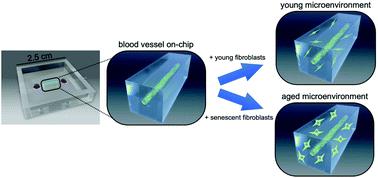当前位置:
X-MOL 学术
›
Biomater. Sci.
›
论文详情
Our official English website, www.x-mol.net, welcomes your feedback! (Note: you will need to create a separate account there.)
A 3D tissue model-on-a-chip for studying the effects of human senescent fibroblasts on blood vessels
Biomaterials Science ( IF 6.6 ) Pub Date : 2020-11-11 , DOI: 10.1039/d0bm01297a Joris Pauty 1, 2, 3, 4 , Shizuka Nakano 1, 2, 3, 4, 5 , Ryo Usuba 1, 2, 3, 4 , Tadaaki Nakajima 1, 2, 3, 4 , Yoshikazu Johmura 2, 6, 7, 8, 9 , Satotaka Omori 2, 6, 7, 8, 9 , Naoya Sakamoto 4, 10, 11, 12, 13 , Akihiko Kikuchi 4, 5, 14, 15, 16 , Makoto Nakanishi 2, 6, 7, 8, 9 , Yukiko T. Matsunaga 1, 2, 3, 4
Biomaterials Science ( IF 6.6 ) Pub Date : 2020-11-11 , DOI: 10.1039/d0bm01297a Joris Pauty 1, 2, 3, 4 , Shizuka Nakano 1, 2, 3, 4, 5 , Ryo Usuba 1, 2, 3, 4 , Tadaaki Nakajima 1, 2, 3, 4 , Yoshikazu Johmura 2, 6, 7, 8, 9 , Satotaka Omori 2, 6, 7, 8, 9 , Naoya Sakamoto 4, 10, 11, 12, 13 , Akihiko Kikuchi 4, 5, 14, 15, 16 , Makoto Nakanishi 2, 6, 7, 8, 9 , Yukiko T. Matsunaga 1, 2, 3, 4
Affiliation

|
All human tissues experience aging that eventually causes organ dysfunction and disease. Cellular senescence was discovered in fibroblasts cultured in vitro. In adults, it is a primary defense mechanism against cancer, but also a major contributor to lifespan limits and disorders associated with aging. To assess how human blood vessels change in an aged environment, we developed an elementary tissue model-on-a-chip that comprises an in vitro three-dimensional model of a blood vessel embedded in a collagen gel with young or senescent skin fibroblasts. We found that senescent fibroblasts mechanically altered the surrounding extracellular matrix by exerting excessive traction stress. We then found that senescent fibroblasts induced sprouting angiogenesis of a microvessel via their senescence-associated secretory phenotype (SASP). Finally, we gathered evidence that the mechanical changes of the microenvironment play a role in sustaining SASP-induced angiogenesis. The model proved useful in monitoring morphological changes in blood vessels induced by senescent fibroblasts while controlling the proportion of senescent cells, and enabled the study of SASP inhibitors, a class of drugs useful in aging and cancer research.
中文翻译:

用于研究人类衰老成纤维细胞对血管的影响的3D芯片组织模型
所有人体组织都会经历衰老,最终导致器官功能障碍和疾病。在体外培养的成纤维细胞中发现了细胞衰老。在成年人中,它是抵抗癌症的主要防御机制,同时也是寿命限制和与衰老相关的疾病的主要因素。为了评估人类血管在老年环境中的变化,我们开发了一种基本的单芯片模型,该模型包括嵌入胶原凝胶中的血管的体外三维模型,该凝胶具有年轻或衰老的皮肤成纤维细胞。我们发现衰老的成纤维细胞通过施加过度的牵引力来机械改变周围的细胞外基质。然后,我们发现衰老的成纤维细胞通过以下途径诱导微血管的发芽血管生成:它们的衰老相关的分泌表型(SASP)。最后,我们收集了证据,证明微环境的机械变化在维持SASP诱导的血管生成中起作用。该模型被证明可用于监测衰老的成纤维细胞诱导的血管形态变化,同时控制衰老细胞的比例,并且使SASP抑制剂的研究成为可能,这是一类对衰老和癌症研究有用的药物。
更新日期:2020-11-12
中文翻译:

用于研究人类衰老成纤维细胞对血管的影响的3D芯片组织模型
所有人体组织都会经历衰老,最终导致器官功能障碍和疾病。在体外培养的成纤维细胞中发现了细胞衰老。在成年人中,它是抵抗癌症的主要防御机制,同时也是寿命限制和与衰老相关的疾病的主要因素。为了评估人类血管在老年环境中的变化,我们开发了一种基本的单芯片模型,该模型包括嵌入胶原凝胶中的血管的体外三维模型,该凝胶具有年轻或衰老的皮肤成纤维细胞。我们发现衰老的成纤维细胞通过施加过度的牵引力来机械改变周围的细胞外基质。然后,我们发现衰老的成纤维细胞通过以下途径诱导微血管的发芽血管生成:它们的衰老相关的分泌表型(SASP)。最后,我们收集了证据,证明微环境的机械变化在维持SASP诱导的血管生成中起作用。该模型被证明可用于监测衰老的成纤维细胞诱导的血管形态变化,同时控制衰老细胞的比例,并且使SASP抑制剂的研究成为可能,这是一类对衰老和癌症研究有用的药物。



























 京公网安备 11010802027423号
京公网安备 11010802027423号